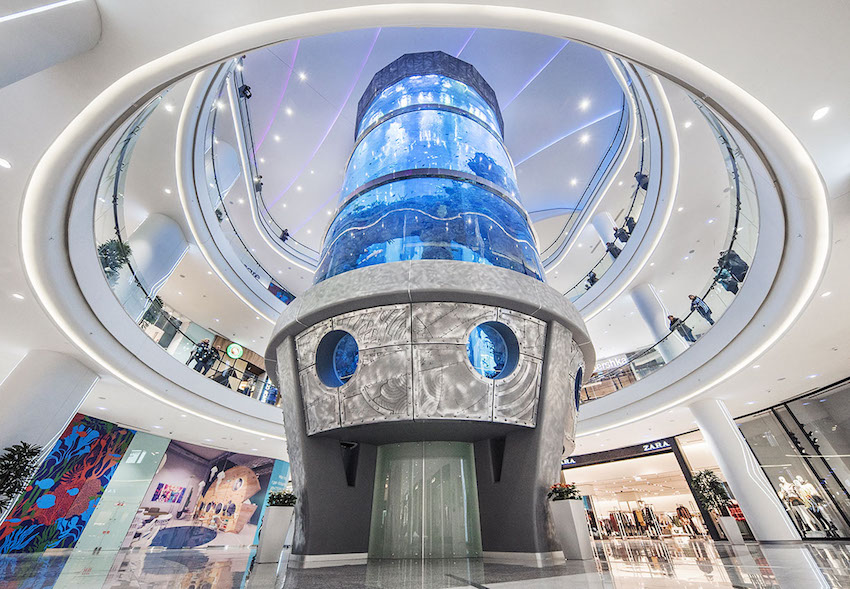The new Oceania Mall in Moscow, Russia is now home to the tallest cylindrical aquarium in the world. Designed and built by International Concept Management (ICM), the 24-meter-tall, 10-meter-wide acrylic aquarium serves as the centerpiece of the new mall, immersing guests in an underwater environment.
The tank holds 900,000 liters of saltwater and was built using 56 pieces of acrylic. Once the individual pieces arrived on site, they were bonded together in specially built technical rooms. Once completed, the largest crane in Russia was needed to lift the massive bonded aquarium pieces into place in the mall. The process, from design to completion, took about 15 months to complete.
Visitors to the mall can enjoy the aquarium from afar, or they can take a hydraulic elevator, the largest in the world, up through the aquarium to get the best view of the 3,200 artificial corals and 50 different species of sharks, rays, and fish found in the tank. The elevator lets its passengers off at the top floor of the mall where they can exit via a walk-through tunnel.
ICM used a filtration system with a modular design so any component can be adjusted without altering the function of the others. The system is located beneath the aquarium and was designed to be hydraulically stable to maximize the integrity of the aquarium.
For more information on the Oceania Mall aquarium, click here.
Related Stories
| Jan 11, 2014
Getting to net-zero energy with brick masonry construction [AIA course]
When targeting net-zero energy performance, AEC professionals are advised to tackle energy demand first. This AIA course covers brick masonry's role in reducing energy consumption in buildings.
Smart Buildings | Jan 7, 2014
9 mega redevelopments poised to transform the urban landscape
Slowed by the recession—and often by protracted negotiations—some big redevelopment plans are now moving ahead. Here’s a sampling of nine major mixed-use projects throughout the country.
| Dec 31, 2013
Top 10 blog posts from 2013
BD+C editors and our contributors posted hundreds of blogs in 2013. Here's a recap of the most popular topics. They include valuable lessons from one of the first BIM-related lawsuits and sage advice from AEC legend Arthur Gensler.
| Dec 20, 2013
Can energy hogs still be considered efficient buildings? Yes, say engineers at Buro Happold
A new tool from the engineering firm Buro Happold takes into account both energy and economic performance of buildings for a true measure of efficiency.
| Dec 13, 2013
Safe and sound: 10 solutions for fire and life safety
From a dual fire-CO detector to an aspiration-sensing fire alarm, BD+C editors present a roundup of new fire and life safety products and technologies.
| Dec 10, 2013
16 great solutions for architects, engineers, and contractors
From a crowd-funded smart shovel to a why-didn’t-someone-do-this-sooner scheme for managing traffic in public restrooms, these ideas are noteworthy for creative problem-solving. Here are some of the most intriguing innovations the BD+C community has brought to our attention this year.
| Nov 27, 2013
Exclusive survey: Revenues increased at nearly half of AEC firms in 2013
Forty-six percent of the respondents to an exclusive BD+C survey of AEC professionals reported that revenues had increased this year compared to 2012, with another 24.2% saying cash flow had stayed the same.
| Nov 27, 2013
Wonder walls: 13 choices for the building envelope
BD+C editors present a roundup of the latest technologies and applications in exterior wall systems, from a tapered metal wall installation in Oklahoma to a textured precast concrete solution in North Carolina.
| Nov 26, 2013
Construction costs rise for 22nd straight month in November
Construction costs in North America rose for the 22nd consecutive month in November as labor costs continued to increase, amid growing industry concern over the tight availability of skilled workers.
| Nov 25, 2013
Building Teams need to help owners avoid 'operational stray'
"Operational stray" occurs when a building’s MEP systems don’t work the way they should. Even the most well-designed and constructed building can stray from perfection—and that can cost the owner a ton in unnecessary utility costs. But help is on the way.

















